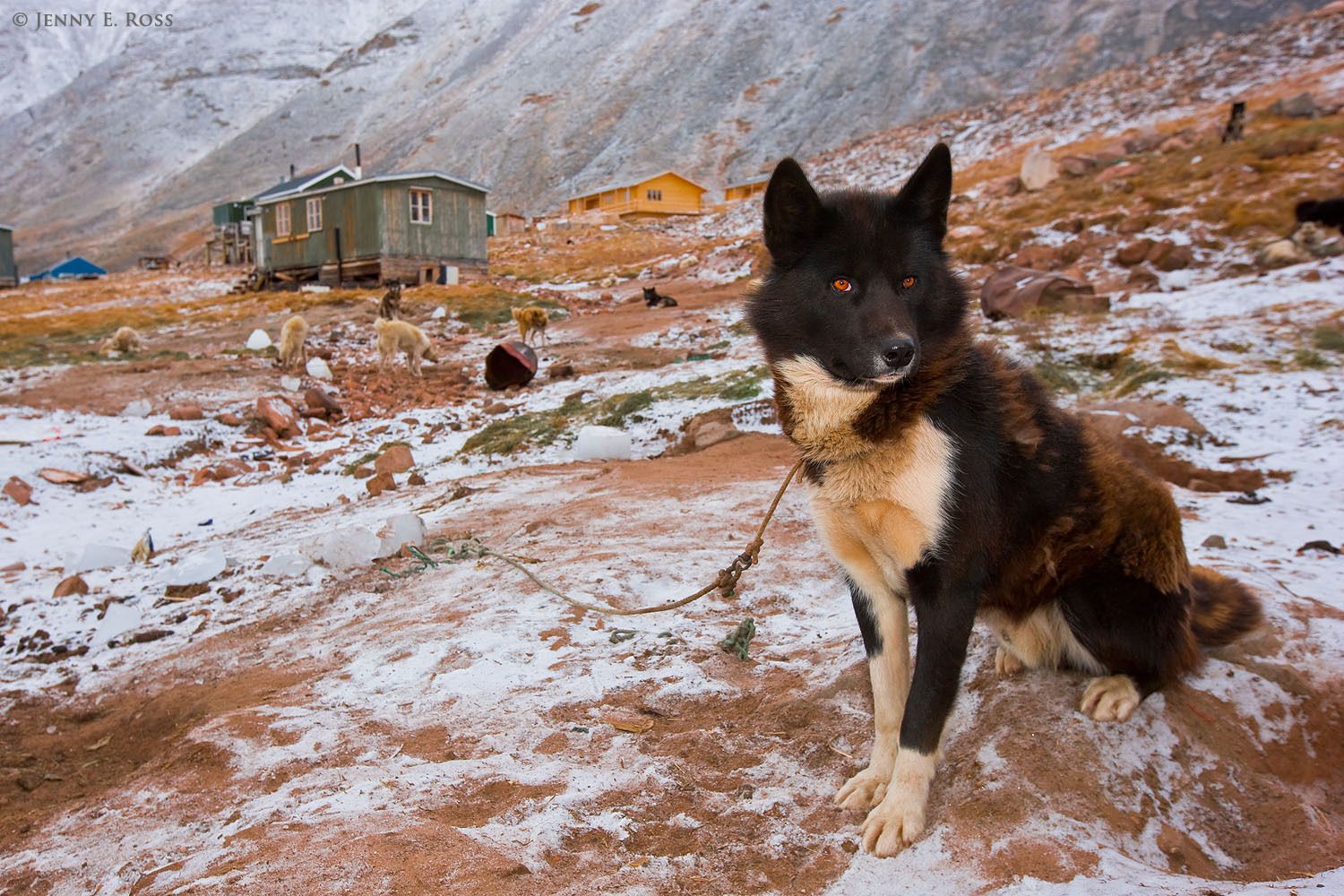-
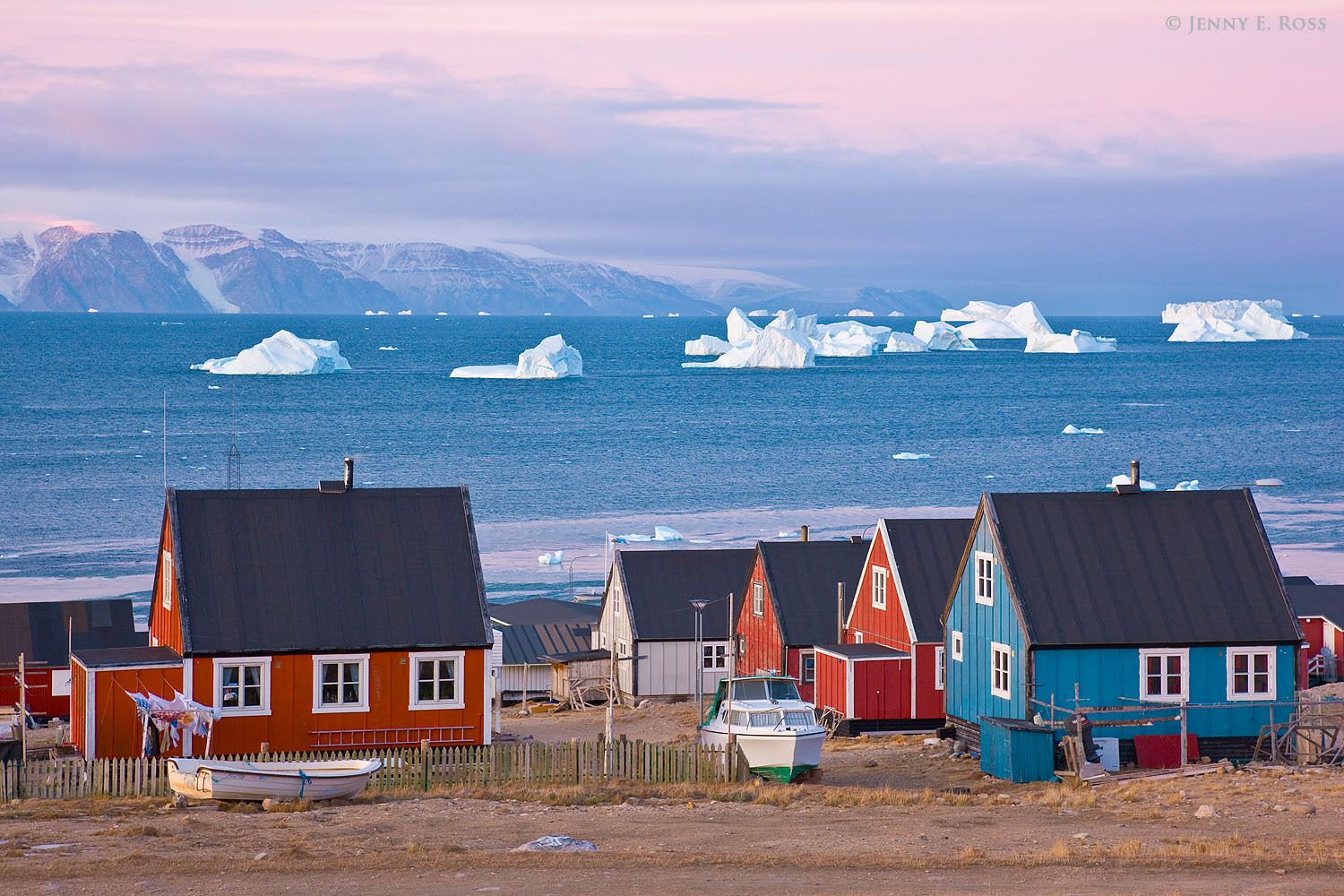
Sunrise in the town of Qaanaaq, at the edge of Murchison Sound in Baffin Bay, Northwest Greenland.
-
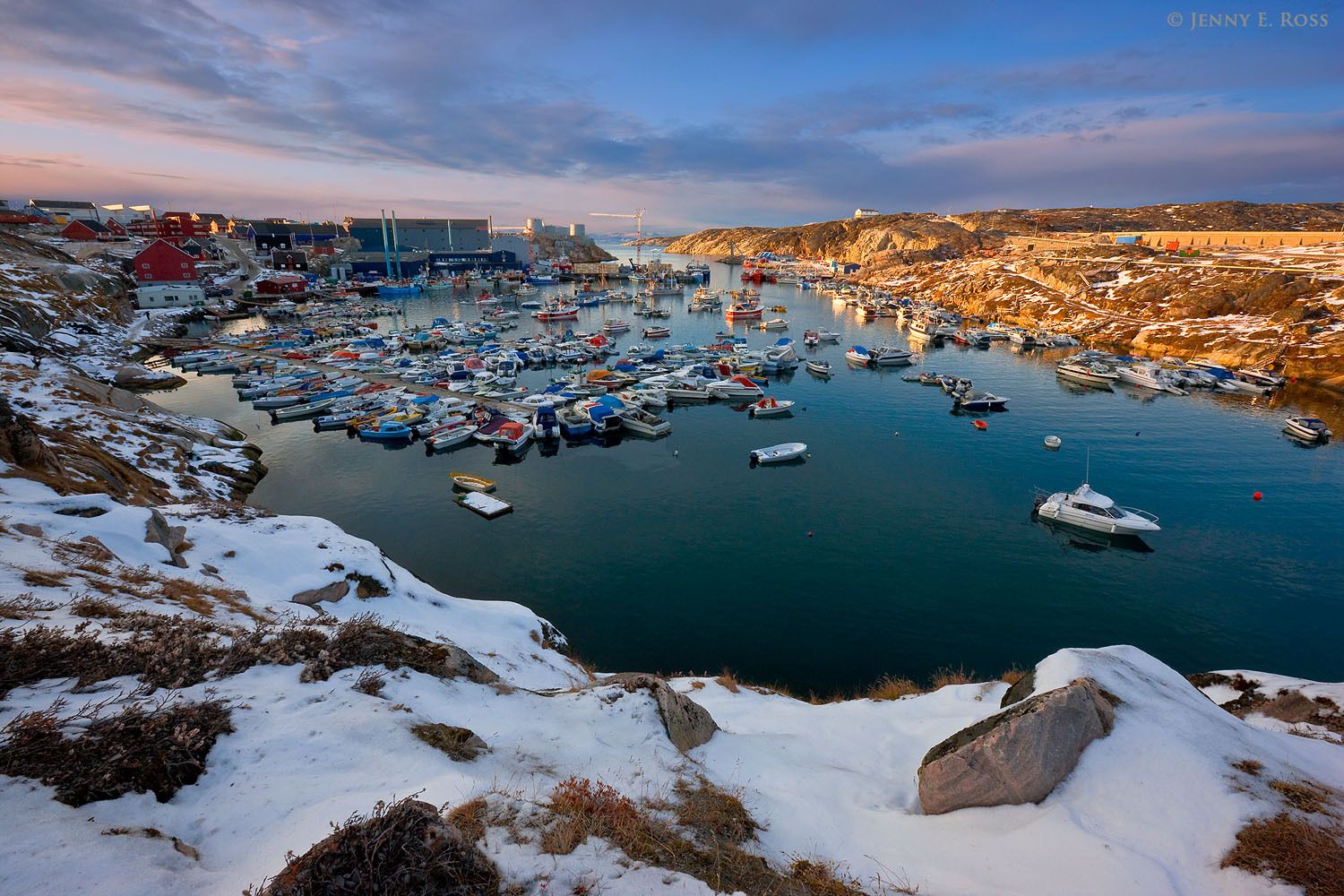
The Ilulissat harbor, filled with fishing boats, in a small fjord connected to Disko Bay in West Greenland.
-
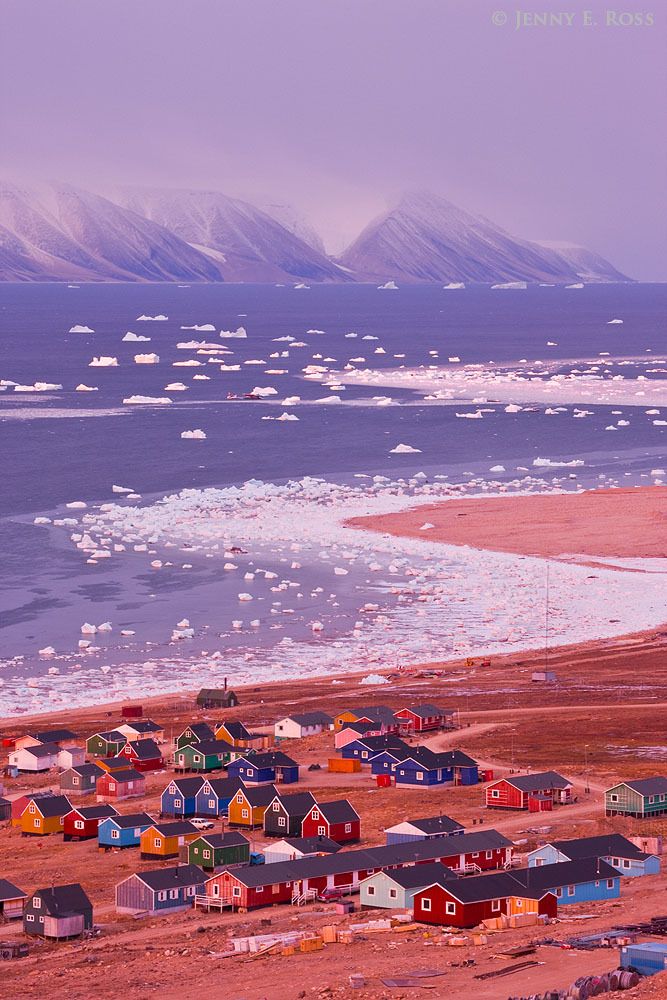
The pink glow of a mid-October dawn illuminates the colorful small houses of Qaanaaq, and the newly-forming sea ice in Murchison Sound, Baffin Bay, Northwest Greenland. Qeqertarsuaq (Herbert Island) is in the distance..
-
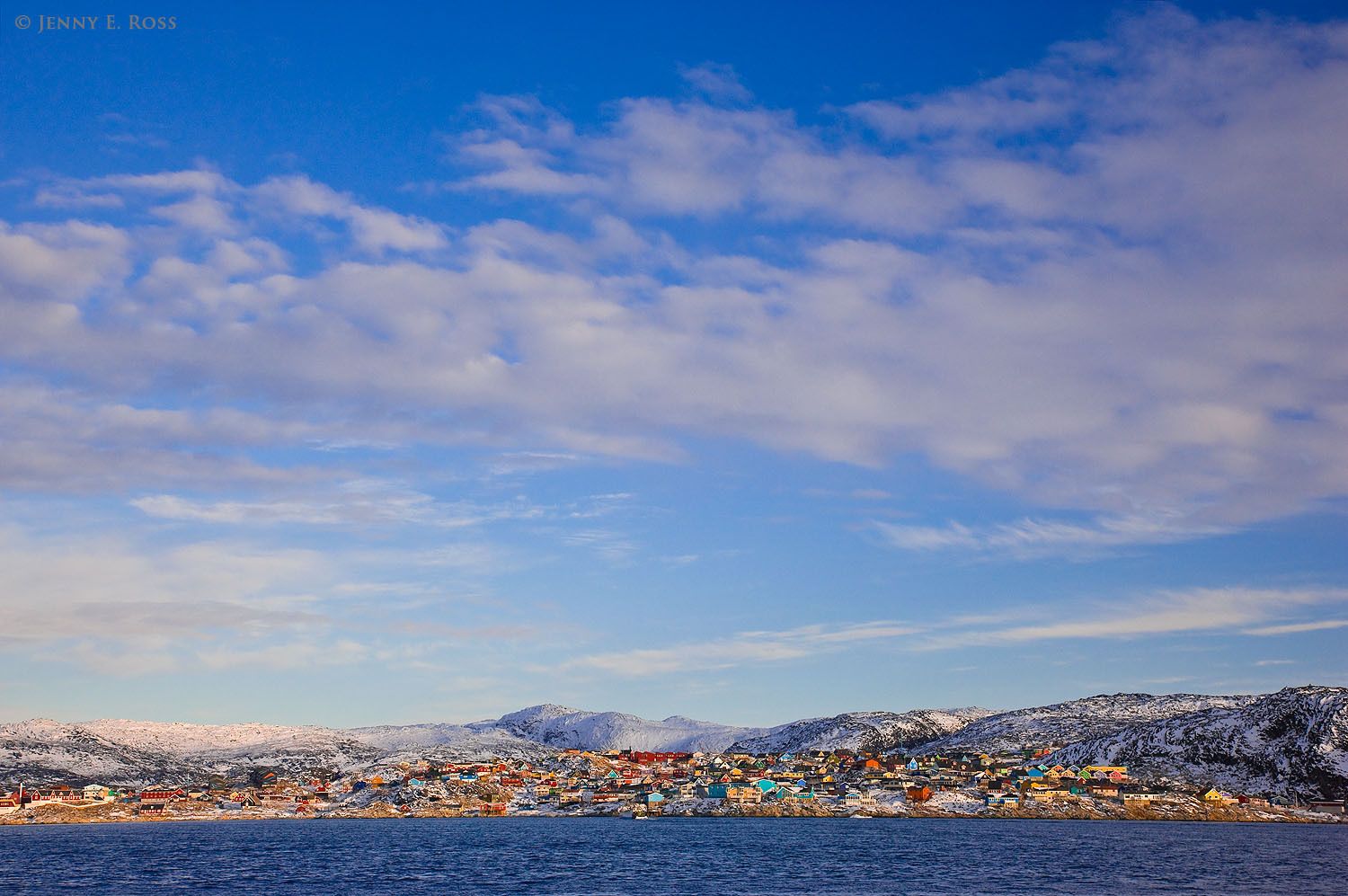
The town of Ilulissat at the edge of Disko Bay, West Greenland
-
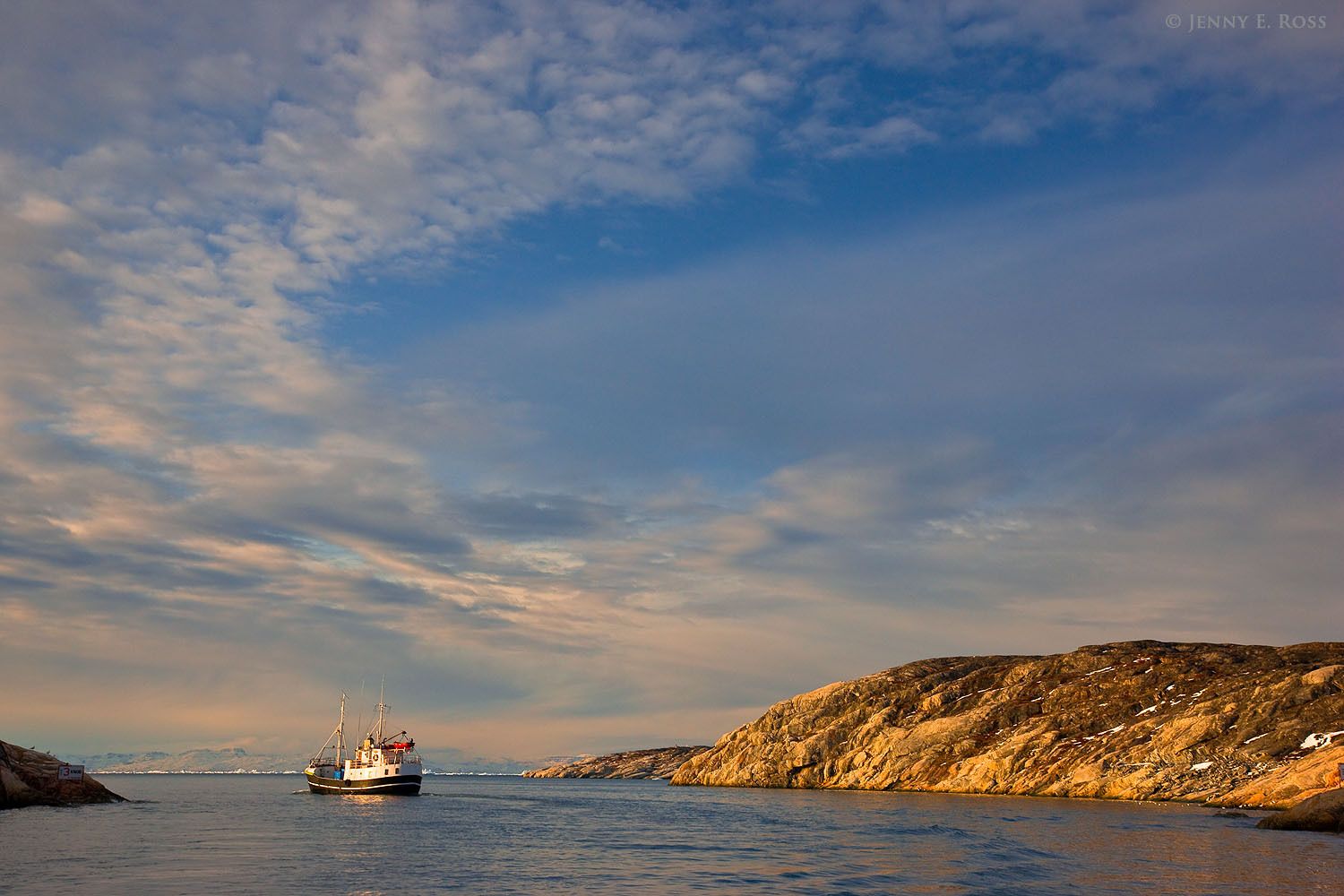
A fishing Boat approaches the Ilulissat harbor in Disko Bay, West Greenland.
-
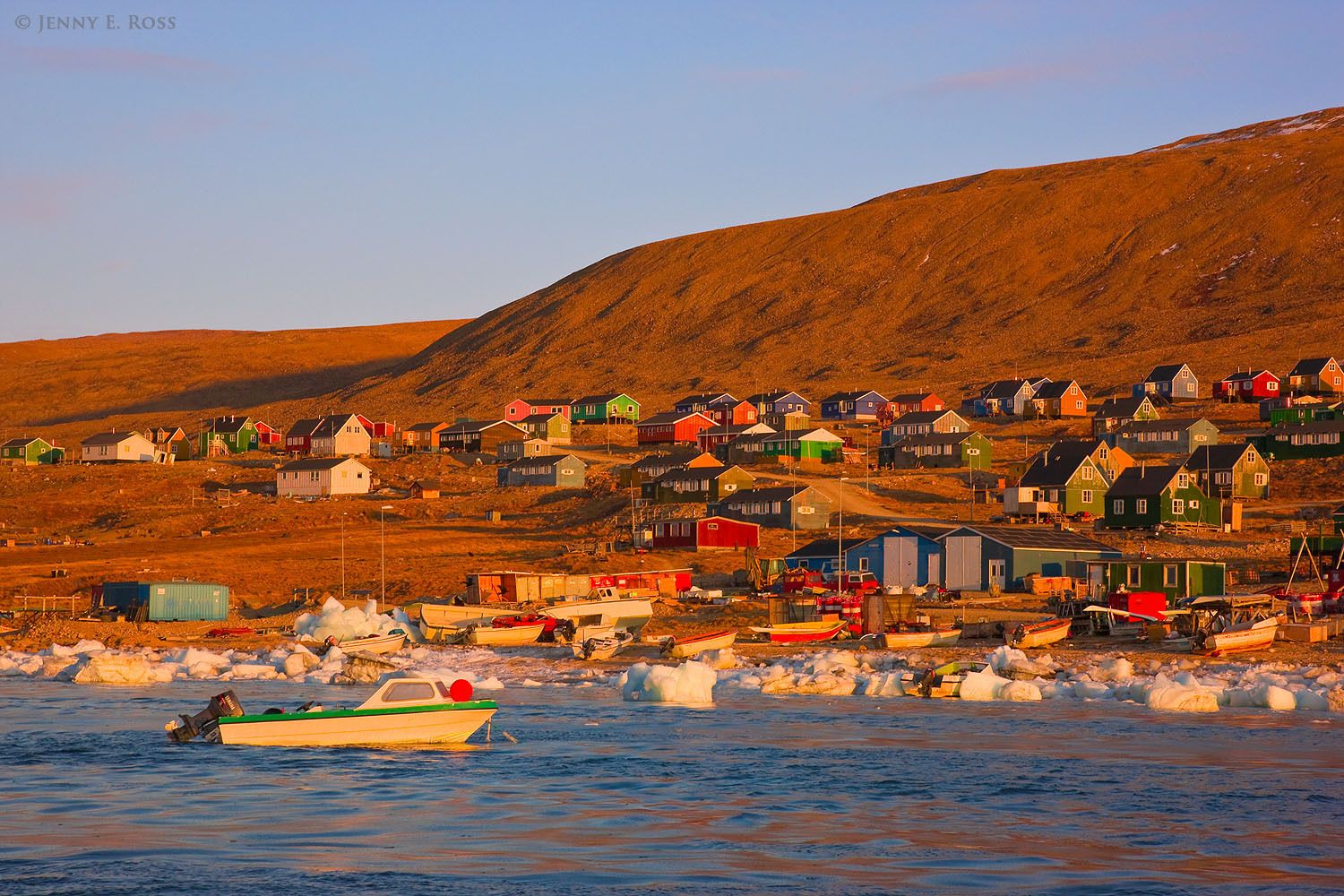
Small boats and colorful houses glow in the early morning light along the shoreline of Qaanaaq, at the edge of Murchison Sound in Baffin Bay, Northwest Greenland.
-
![Tradtional Inuit Drum Dance, performed by Navarana Dvneq at sunset on the shore of Baffin Bay near Qaanaaq (aka Thule), Northwest Greenland. She is wearing traditional Inuit clothing, including the fur of polar bear and caribou. The drum itself is made from seal skin. Traditional Inuit drum dance, Baffin Bay, Northwest Greenland.]()
Traditional Inuit drum dance, Baffin Bay, Northwest Greenland.
Tradtional Inuit Drum Dance, performed by Navarana Dvneq at sunset on the shore of Baffin Bay near Qaanaaq (aka Thule), Northwest Greenland. She is wearing traditional Inuit clothing, including the fur of polar bear and caribou. The drum itself is made from seal skin.
-
![A tradtional Inuit drum dance, performed by Navarana Dvneq (woman on the right side) and Inukitsoq Sadorana (man on the left side) at sunset on the shore of Baffin Bay near Qaanaaq (aka Thule), Northwest Greenland. They are wearing traditional Inuit clothing, which includes the fur of polar bear, caribou, and seal. The drum itself is made from seal skin. Traditional Inuit drum dance, Baffin Bay, Northwest Greenland.]()
Traditional Inuit drum dance, Baffin Bay, Northwest Greenland.
A tradtional Inuit drum dance, performed by Navarana Dvneq (woman on the right side) and Inukitsoq Sadorana (man on the left side) at sunset on the shore of Baffin Bay near Qaanaaq (aka Thule), Northwest Greenland. They are wearing traditional Inuit clothing, which includes the fur of polar bear, caribou, and seal. The drum itself is made from seal skin.
-
![Small boats glow in the early morning light along the shoreline of Qaanaaq, at the edge of Murchison Sound in Baffin Bay, Northwest Greenland.]()
Small boats glow in the early morning light along the shoreline of Qaanaaq, at the edge of Murchison Sound in Baffin Bay, Northwest Greenland.
-
![Indigenous Greenlandic people (of Inuit and combined Inuit-Danish descent) are assigned an annual quota by the government for hunting narwhals and other marine mammals. The narwhal is designated as a Near Threatened species on the IUCN Red List of Threatened Species. Strips of narwhal (Monodon monoceros) meat hanging to dry next to a small boat at the Baffin Bay shoreline in Qaanaaq, Northwest Greenland.]()
Strips of narwhal (Monodon monoceros) meat hanging to dry next to a small boat at the Baffin Bay shoreline in Qaanaaq, Northwest Greenland.
Indigenous Greenlandic people (of Inuit and combined Inuit-Danish descent) are assigned an annual quota by the government for hunting narwhals and other marine mammals. The narwhal is designated as a Near Threatened species on the IUCN Red List of Threatened Species.
-
![A young Inuit child looks out a window in Qaanaaq, Northwest Greenland.]()
A young Inuit child looks out a window in Qaanaaq, Northwest Greenland.
-
![The hunter's pants and the cuffs of his gloves are made of polar bear fur, his jacket is constructed from a caribou pelt, and his boots and gloves are seal skin. Inuit hunter Kristian Eipe wearing the tradtional clothing he uses when on a hunting expedition, in the modern setting of his home in Qaanaaq, Northwest Greenland.]()
Inuit hunter Kristian Eipe wearing the tradtional clothing he uses when on a hunting expedition, in the modern setting of his home in Qaanaaq, Northwest Greenland.
The hunter's pants and the cuffs of his gloves are made of polar bear fur, his jacket is constructed from a caribou pelt, and his boots and gloves are seal skin.
-
![A tractor loader collects large chunks of ice along the shoreline of Qaanaaq at the edge of Murchison Sund in northern Baffin Bay, Northwest Greenland. The ice, which comes from disintegrating icebergs, is melted and purified to make freshwater for use throughout the small town of Qaanaaq. Collecting ice to make water, Qaanaaq, Northwest Greenland.]()
Collecting ice to make water, Qaanaaq, Northwest Greenland.
A tractor loader collects large chunks of ice along the shoreline of Qaanaaq at the edge of Murchison Sund in northern Baffin Bay, Northwest Greenland. The ice, which comes from disintegrating icebergs, is melted and purified to make freshwater for use throughout the small town of Qaanaaq.
-
![For thousands of years the Inuit people have subsisted by hunting marine mammals on the Arctic sea ice using dogsleds. Their ability to hunt in that manner is now being affected by climate change. Due to warming temperatures, the sea ice is freezing later in the fall and breaking up earlier in the spring, and it is thinner during the winter. Hunting by dogsled is possible for a much shorter period of time now than in the past, and it is much more dangerous due to unreliable ice conditions. An Inuit sledge (dogsled), used for hunting with dog teams on the sea ice, lies idle near the shoreline of the unfrozen sea in Siorapaluk, Northwest Greenland.]()
An Inuit sledge (dogsled), used for hunting with dog teams on the sea ice, lies idle near the shoreline of the unfrozen sea in Siorapaluk, Northwest Greenland.
For thousands of years the Inuit people have subsisted by hunting marine mammals on the Arctic sea ice using dogsleds. Their ability to hunt in that manner is now being affected by climate change. Due to warming temperatures, the sea ice is freezing later in the fall and breaking up earlier in the spring, and it is thinner during the winter. Hunting by dogsled is possible for a much shorter period of time now than in the past, and it is much more dangerous due to unreliable ice conditions.
-
![Siorapaluk is a very small Inuit settlement, and is the northernmost indigenous community in the world. The residents still live a traditional subsistence lifestyle based on hunting marine mammals (using boats in the ice-free season and dogsleds when there is sufficient sea ice). In 2009 when this photograph was taken, there were about 70 people living there; but by the winter of 2011, the population had decreased to 20. Due to climate change, hunting has become increasingly difficult, and feeding a family and a team of sled dogs in the traditional manner has become too problematic to be reliable. Exterior detail of a small house in Siorapaluk, Northwest Greenland.]()
Exterior detail of a small house in Siorapaluk, Northwest Greenland.
Siorapaluk is a very small Inuit settlement, and is the northernmost indigenous community in the world. The residents still live a traditional subsistence lifestyle based on hunting marine mammals (using boats in the ice-free season and dogsleds when there is sufficient sea ice). In 2009 when this photograph was taken, there were about 70 people living there; but by the winter of 2011, the population had decreased to 20. Due to climate change, hunting has become increasingly difficult, and feeding a family and a team of sled dogs in the traditional manner has become too problematic to be reliable.
-
![The Greenland sled dog is a distinct and ancient breed, thought to be directly descended from the dogs brought to Greenland by the first Inuit settlers. It is believed to be the only pure-bred aboriginal dog remaining in the Arctic. By law, in order to preserve the genetic purity of these animals, no other dog breeds are allowed in Northwest Greenland. Although the Inuit in Alaska and Canada now typically use snowmobiles rather than sled dogs, indigenous Greenlanders in the far north still rely upon traditional dog teams and wooden sledges for winter hunting. Greenland Sled Dog, Siorapaluk, Northwest Greenland.]()
Greenland Sled Dog, Siorapaluk, Northwest Greenland.
The Greenland sled dog is a distinct and ancient breed, thought to be directly descended from the dogs brought to Greenland by the first Inuit settlers. It is believed to be the only pure-bred aboriginal dog remaining in the Arctic. By law, in order to preserve the genetic purity of these animals, no other dog breeds are allowed in Northwest Greenland. Although the Inuit in Alaska and Canada now typically use snowmobiles rather than sled dogs, indigenous Greenlanders in the far north still rely upon traditional dog teams and wooden sledges for winter hunting.
-
![The Greenland Dog is a distinct and ancient breed, thought to be directly descended from the dogs brought to Greenland by the first Inuit settlers. Sled dogs are working animals, not pets. They are kept outside at all times, chained or tethered on a long lead, when they are not actually working. They are only fed about once a week when there is no snow or sea ice and they are not working, since they burn comparatively few calories just lying around. In addition, without meat from hunting, in very remote regions there is not enough food for both people and dogs. No snow or sea ice, and a Greenland sled dog with no work to do in Siorapaluk, Northwest Greenland.]()
No snow or sea ice, and a Greenland sled dog with no work to do in Siorapaluk, Northwest Greenland.
The Greenland Dog is a distinct and ancient breed, thought to be directly descended from the dogs brought to Greenland by the first Inuit settlers. Sled dogs are working animals, not pets. They are kept outside at all times, chained or tethered on a long lead, when they are not actually working. They are only fed about once a week when there is no snow or sea ice and they are not working, since they burn comparatively few calories just lying around. In addition, without meat from hunting, in very remote regions there is not enough food for both people and dogs.
-
![Siorapaluk is a very small Inuit settlement, and is the northernmost indigenous community in the world. It The residents still live a traditional subsistence lifestyle based on hunting marine mammals (using boats in the ice-free season and dogsleds when there is sufficient sea ice). In 2009 when this photograph was taken, there were about 70 people living there; but by the winter of 2011, the population had decreased to 20. Due to climate change, hunting has become increasingly difficult, and feeding a family and a team of sled dogs in the traditional manner has become too problematic to be reliable. This elementary school has been closed, and all children have been relocated farther south. Children in the Siorapaluk elementary school, Northwest Greenland.]()
Children in the Siorapaluk elementary school, Northwest Greenland.
Siorapaluk is a very small Inuit settlement, and is the northernmost indigenous community in the world. It The residents still live a traditional subsistence lifestyle based on hunting marine mammals (using boats in the ice-free season and dogsleds when there is sufficient sea ice). In 2009 when this photograph was taken, there were about 70 people living there; but by the winter of 2011, the population had decreased to 20. Due to climate change, hunting has become increasingly difficult, and feeding a family and a team of sled dogs in the traditional manner has become too problematic to be reliable. This elementary school has been closed, and all children have been relocated farther south.
-
![Siorapaluk is a very small Inuit settlement, and is the northernmost indigenous community in the world. It The residents still live a traditional subsistence lifestyle based on hunting marine mammals (using boats in the ice-free season and dogsleds when there is sufficient sea ice). In 2009 when this photograph was taken, there were about 70 people living there; but by the winter of 2011, the population had decreased to 20. Due to climate change, hunting has become increasingly difficult, and feeding a family and a team of sled dogs in the traditional manner has become too problematic to be reliable. This elementary school has been closed, and all children have been relocated farther south. Children in the Siorapaluk elementary school, Northwest Greenland.]()
Children in the Siorapaluk elementary school, Northwest Greenland.
Siorapaluk is a very small Inuit settlement, and is the northernmost indigenous community in the world. It The residents still live a traditional subsistence lifestyle based on hunting marine mammals (using boats in the ice-free season and dogsleds when there is sufficient sea ice). In 2009 when this photograph was taken, there were about 70 people living there; but by the winter of 2011, the population had decreased to 20. Due to climate change, hunting has become increasingly difficult, and feeding a family and a team of sled dogs in the traditional manner has become too problematic to be reliable. This elementary school has been closed, and all children have been relocated farther south.
-
![Siorapaluk is a very small Inuit settlement, and is the northernmost indigenous community in the world. It The residents still live a traditional subsistence lifestyle based on hunting marine mammals (using boats in the ice-free season and dogsleds when there is sufficient sea ice). In 2009 when this photograph was taken, there were about 70 people living there; but by the winter of 2011, the population had decreased to 20. Due to climate change, hunting has become increasingly difficult, and feeding a family and a team of sled dogs in the traditional manner has become too problematic to be reliable. This elementary school has been closed, and all children have been relocated farther south. Children displaying their drawings of marine mammals in the Siorapaluk elementary school, Northwest Greenland.]()
Children displaying their drawings of marine mammals in the Siorapaluk elementary school, Northwest Greenland.
Siorapaluk is a very small Inuit settlement, and is the northernmost indigenous community in the world. It The residents still live a traditional subsistence lifestyle based on hunting marine mammals (using boats in the ice-free season and dogsleds when there is sufficient sea ice). In 2009 when this photograph was taken, there were about 70 people living there; but by the winter of 2011, the population had decreased to 20. Due to climate change, hunting has become increasingly difficult, and feeding a family and a team of sled dogs in the traditional manner has become too problematic to be reliable. This elementary school has been closed, and all children have been relocated farther south.
-
![For thousands of years the Inuit people have subsisted by hunting marine mammals on the Arctic sea ice using dogsleds. Their ability to hunt in that manner is now being affected by climate change. Due to warming temperatures, the sea ice is freezing later in the fall and breaking up earlier in the spring, and it is thinner during the winter. Hunting by dogsled is possible for a much shorter period of time now than in the past, and it is much more dangerous due to unreliable ice conditions. An Inuit sledge (dogsled), used for hunting with dog teams on the sea ice, lies idle near the shoreline of the unfrozen sea in Siorapaluk, Northwest Greenland.]()
An Inuit sledge (dogsled), used for hunting with dog teams on the sea ice, lies idle near the shoreline of the unfrozen sea in Siorapaluk, Northwest Greenland.
For thousands of years the Inuit people have subsisted by hunting marine mammals on the Arctic sea ice using dogsleds. Their ability to hunt in that manner is now being affected by climate change. Due to warming temperatures, the sea ice is freezing later in the fall and breaking up earlier in the spring, and it is thinner during the winter. Hunting by dogsled is possible for a much shorter period of time now than in the past, and it is much more dangerous due to unreliable ice conditions.
-
![Siorapaluk is a very small Inuit settlement, and is the northernmost indigenous community in the world. It The residents still live a traditional subsistence lifestyle based on hunting marine mammals (using boats in the ice-free season and dogsleds when there is sufficient sea ice). In 2009 when this photograph was taken, there were about 70 people living there; but by the winter of 2011, the population had decreased to 20. Due to climate change, hunting has become increasingly difficult, and feeding a family and a team of sled dogs in the traditional manner has become too problematic to be reliable. The cemetery in Siorapaluk, Northwest Greenland.]()
The cemetery in Siorapaluk, Northwest Greenland.
Siorapaluk is a very small Inuit settlement, and is the northernmost indigenous community in the world. It The residents still live a traditional subsistence lifestyle based on hunting marine mammals (using boats in the ice-free season and dogsleds when there is sufficient sea ice). In 2009 when this photograph was taken, there were about 70 people living there; but by the winter of 2011, the population had decreased to 20. Due to climate change, hunting has become increasingly difficult, and feeding a family and a team of sled dogs in the traditional manner has become too problematic to be reliable.
-
![The Greenland sled dog is a distinct and ancient breed, thought to be directly descended from the dogs brought to Greenland by the first Inuit settlers. It is believed to be the only pure-bred aboriginal dog remaining in the Arctic. By law, in order to preserve the genetic purity of these animals, no other dog breeds are allowed in Northwest Greenland. Although the Inuit in Alaska and Canada now typically use snowmobiles rather than sled dogs, indigenous Greenlanders in the far north still rely upon traditional dog teams and wooden sledges for winter hunting. Idle sledges, no snow or sea ice, and a Greenland sled dog with no work to do. Siorapaluk, Northwest Greenland.]()
Idle sledges, no snow or sea ice, and a Greenland sled dog with no work to do. Siorapaluk, Northwest Greenland.
The Greenland sled dog is a distinct and ancient breed, thought to be directly descended from the dogs brought to Greenland by the first Inuit settlers. It is believed to be the only pure-bred aboriginal dog remaining in the Arctic. By law, in order to preserve the genetic purity of these animals, no other dog breeds are allowed in Northwest Greenland. Although the Inuit in Alaska and Canada now typically use snowmobiles rather than sled dogs, indigenous Greenlanders in the far north still rely upon traditional dog teams and wooden sledges for winter hunting.
-
![The Greenland sled dog is a distinct and ancient breed, thought to be directly descended from the dogs brought to Greenland by the first Inuit settlers. It is believed to be the only pure-bred aboriginal dog remaining in the Arctic. By law, in order to preserve the genetic purity of these animals, no other dog breeds are allowed in Northwest Greenland. Although the Inuit in Alaska and Canada now typically use snowmobiles rather than sled dogs, indigenous Greenlanders in the far north still rely upon traditional dog teams and wooden sledges for winter hunting. Restless sled dogs wait for sea ice to form in Siorapaluk, Northwest Greenland.]()
Restless sled dogs wait for sea ice to form in Siorapaluk, Northwest Greenland.
The Greenland sled dog is a distinct and ancient breed, thought to be directly descended from the dogs brought to Greenland by the first Inuit settlers. It is believed to be the only pure-bred aboriginal dog remaining in the Arctic. By law, in order to preserve the genetic purity of these animals, no other dog breeds are allowed in Northwest Greenland. Although the Inuit in Alaska and Canada now typically use snowmobiles rather than sled dogs, indigenous Greenlanders in the far north still rely upon traditional dog teams and wooden sledges for winter hunting.
-
![The Greenland Dog is a distinct and ancient breed, thought to be directly descended from the dogs brought to Greenland by the first Inuit settlers. Sled dogs are working animals, not pets. They are kept outside at all times, chained or tethered on a long lead, when they are not actually working. They are only fed about once a week when there is no snow or sea ice and they are not working, since they burn comparatively few calories just lying around. In addition, without meat from hunting, in very remote regions there is not enough food for both people and dogs. No snow or sea ice, and a Greenland sled dog with no work to do in Siorapaluk, Northwest Greenland.]()
No snow or sea ice, and a Greenland sled dog with no work to do in Siorapaluk, Northwest Greenland.
The Greenland Dog is a distinct and ancient breed, thought to be directly descended from the dogs brought to Greenland by the first Inuit settlers. Sled dogs are working animals, not pets. They are kept outside at all times, chained or tethered on a long lead, when they are not actually working. They are only fed about once a week when there is no snow or sea ice and they are not working, since they burn comparatively few calories just lying around. In addition, without meat from hunting, in very remote regions there is not enough food for both people and dogs.
-
![Greenland sled dogs are working animals, not pets. They are typically fed meat obtained by their owners from hunting. Because climate change has shortened the period of time each year when dog sleds can be used for hunting, some hunters in remote regions kill their dogs (or request that they be killed by the town's licensed "dog killer") when it becomes too expensive or problematic to feed them with store-bought food. The so-called "mercy killing" of dogs in Qaanaaq, Northwest Greenland, has become so common that the corpse of this animal lying alongside a heavily used walking route didn't even attract any attention from passersby. A dead sled dog in Qaanaaq, Northwest Greenland.]()
A dead sled dog in Qaanaaq, Northwest Greenland.
Greenland sled dogs are working animals, not pets. They are typically fed meat obtained by their owners from hunting. Because climate change has shortened the period of time each year when dog sleds can be used for hunting, some hunters in remote regions kill their dogs (or request that they be killed by the town's licensed "dog killer") when it becomes too expensive or problematic to feed them with store-bought food. The so-called "mercy killing" of dogs in Qaanaaq, Northwest Greenland, has become so common that the corpse of this animal lying alongside a heavily used walking route didn't even attract any attention from passersby.
-
![Without sea ice, hunting by dogsled is impossible. But with new ice beginning to form, hunting by small boat can be very dangerous. A subsistence hunt of Atlantic walrus (Odobenus rosmarus rosmarus) by inidgenous Inuit hunters in Northwest Greenland.]()
A subsistence hunt of Atlantic walrus (Odobenus rosmarus rosmarus) by inidgenous Inuit hunters in Northwest Greenland.
Without sea ice, hunting by dogsled is impossible. But with new ice beginning to form, hunting by small boat can be very dangerous.
-
![A subsistence hunt of Atlantic walrus (Odobenus rosmarus rosmarus) by inidgenous Inuit hunters in Northwest Greenland.]()
A subsistence hunt of Atlantic walrus (Odobenus rosmarus rosmarus) by inidgenous Inuit hunters in Northwest Greenland.
-
![A subsistence hunt of Atlantic walrus (Odobenus rosmarus rosmarus) by inidgenous Inuit hunters in Northwest Greenland.]()
A subsistence hunt of Atlantic walrus (Odobenus rosmarus rosmarus) by inidgenous Inuit hunters in Northwest Greenland.
-
![A female Atlantic walrus (Odobenus rosmarus rosmarus), killed by indigenous Inuit hunters during a subsistence hunt in a very remote region of Northwest Greenland, is towed behind their small boat.]()
A female Atlantic walrus (Odobenus rosmarus rosmarus), killed by indigenous Inuit hunters during a subsistence hunt in a very remote region of Northwest Greenland, is towed behind their small boat.
-
![After killing two Atlantic walruses (Odobenus rosmarus rosmarus) for food, indigenous Inuit hunters prepare to butcher the carcasses on a small floe of sea ice in remote Northwest Greenland.]()
After killing two Atlantic walruses (Odobenus rosmarus rosmarus) for food, indigenous Inuit hunters prepare to butcher the carcasses on a small floe of sea ice in remote Northwest Greenland.
-
![After killing two Atlantic walruses (Odobenus rosmarus rosmarus) for food, indigenous Inuit hunters begin butchering the carcasses on a small floe of sea ice in remote Northwest Greenland.]()
After killing two Atlantic walruses (Odobenus rosmarus rosmarus) for food, indigenous Inuit hunters begin butchering the carcasses on a small floe of sea ice in remote Northwest Greenland.
-
![After killing two Atlantic walruses (Odobenus rosmarus rosmarus) for food, indigenous Inuit hunters butcher the carcasses on a small floe of sea ice in remote Northwest Greenland.]()
After killing two Atlantic walruses (Odobenus rosmarus rosmarus) for food, indigenous Inuit hunters butcher the carcasses on a small floe of sea ice in remote Northwest Greenland.
-
![Following a subsistence hunt for walrus, seals, and musk ox, an indigenous Inuit hunter brings his share of the meat ashore in Siorapaluk, Northwest Greenland.]()
Following a subsistence hunt for walrus, seals, and musk ox, an indigenous Inuit hunter brings his share of the meat ashore in Siorapaluk, Northwest Greenland.
-
![Siorapaluk, Northwest Greenland. Walrus and seal meat from subsistence hunting being stored in the cold air on elevated wooden platforms to prevent scavenging by animals.]()
Walrus and seal meat from subsistence hunting being stored in the cold air on elevated wooden platforms to prevent scavenging by animals.
Siorapaluk, Northwest Greenland.
-
![The Greenland Dog is a distinct and ancient breed, thought to be directly descended from the dogs brought to Greenland by the first Inuit settlers. Sled dogs are working animals, not pets. They are kept outside at all times, chained or tethered on a long lead, when they are not actually working. They are only fed about once a week when there is no snow or sea ice and they are not working, since they burn comparatively few calories just lying around. In addition, without meat from hunting, in very remote regions there is not enough food for both people and dogs. A Greenland sled dog and her young puppies eat walrus meat from a subsistence hunt in Siorapaluk, Northwest Greenland.]()
A Greenland sled dog and her young puppies eat walrus meat from a subsistence hunt in Siorapaluk, Northwest Greenland.
The Greenland Dog is a distinct and ancient breed, thought to be directly descended from the dogs brought to Greenland by the first Inuit settlers. Sled dogs are working animals, not pets. They are kept outside at all times, chained or tethered on a long lead, when they are not actually working. They are only fed about once a week when there is no snow or sea ice and they are not working, since they burn comparatively few calories just lying around. In addition, without meat from hunting, in very remote regions there is not enough food for both people and dogs.
-
![The Greenland Dog is a distinct and ancient breed, thought to be directly descended from the dogs brought to Greenland by the first Inuit settlers. Sled dogs are working animals, not pets. They are kept outside at all times, chained or tethered on a long lead, when they are not actually working. They are only fed about once a week when there is no snow or sea ice and they are not working, since they burn comparatively few calories just lying around. In addition, without meat from hunting, in very remote regions there is not enough food for both people and dogs. A Greenland sled dog puppy eating walrus meat in Siorapaluk, Northwest Greenland.]()
A Greenland sled dog puppy eating walrus meat in Siorapaluk, Northwest Greenland.
The Greenland Dog is a distinct and ancient breed, thought to be directly descended from the dogs brought to Greenland by the first Inuit settlers. Sled dogs are working animals, not pets. They are kept outside at all times, chained or tethered on a long lead, when they are not actually working. They are only fed about once a week when there is no snow or sea ice and they are not working, since they burn comparatively few calories just lying around. In addition, without meat from hunting, in very remote regions there is not enough food for both people and dogs.
-
![An ulu and other traditional Inuit tools for scraping animal hides and preparing leather and finished animal pelts, Northwest Greenland.]()
An ulu and other traditional Inuit tools for scraping animal hides and preparing leather and finished animal pelts, Northwest Greenland.
-
![In some remote regions of Greenland, the indigenous people still rely on hunting for food, just as their ancestors did for thousands of years before them. There is an annual quota for musk oxen, to prevent the animal populations from being depleted. An adult male musk ox (Ovibos moschatus) tumbles down a hill in Northwest Greenland after being shot by indigenous Inuit hunters.]()
An adult male musk ox (Ovibos moschatus) tumbles down a hill in Northwest Greenland after being shot by indigenous Inuit hunters.
In some remote regions of Greenland, the indigenous people still rely on hunting for food, just as their ancestors did for thousands of years before them. There is an annual quota for musk oxen, to prevent the animal populations from being depleted.
-
![In some remote regions of Greenland, the indigenous people still rely on hunting as their primary means of subsistence, just as their ancestors did for thousands of years before them. There is an annual quota for musk oxen, to prevent the animal populations from being depleted. Inuit hunters butcher an adult male musk ox (Ovibos moschatus) they have killed for food, and remove the animal's pelt.]()
Inuit hunters butcher an adult male musk ox (Ovibos moschatus) they have killed for food, and remove the animal's pelt.
In some remote regions of Greenland, the indigenous people still rely on hunting as their primary means of subsistence, just as their ancestors did for thousands of years before them. There is an annual quota for musk oxen, to prevent the animal populations from being depleted.
-
![In some remote regions of Greenland, the indigenous people still rely on hunting as their primary means of subsistence, just as their ancestors did for thousands of years before them. There is an annual quota for musk oxen, to prevent the animal populations from being depleted. Inuit hunters butcher an adult male musk ox (Ovibos moschatus) they have killed for food, and remove the animal's pelt.]()
Inuit hunters butcher an adult male musk ox (Ovibos moschatus) they have killed for food, and remove the animal's pelt.
In some remote regions of Greenland, the indigenous people still rely on hunting as their primary means of subsistence, just as their ancestors did for thousands of years before them. There is an annual quota for musk oxen, to prevent the animal populations from being depleted.
-
![In some remote regions of Greenland, the indigenous people still rely on hunting as their primary means of subsistence, just as their ancestors did for thousands of years before them. There is an annual quota for musk oxen, to prevent the animal populations from being depleted. Inuit hunters butcher an adult male musk ox (Ovibos moschatus) they have killed for food, and remove the animal's pelt.]()
Inuit hunters butcher an adult male musk ox (Ovibos moschatus) they have killed for food, and remove the animal's pelt.
In some remote regions of Greenland, the indigenous people still rely on hunting as their primary means of subsistence, just as their ancestors did for thousands of years before them. There is an annual quota for musk oxen, to prevent the animal populations from being depleted.
-
![Following a subsistence hunt of Atlantic walrus (Odobenus rosmarus rosmarus) and musk ox (Ovibos moschatus) by indigenous Inuit hunters in a remote region of Northwest Greenland, their boat is packed with walrus and musk ox meat. The pelt also came from a musk ox. Hunting of both species is governed by a quota system in Greenland, to ensure the animal populations are not depleted. A small boat is filled with walrus and musk ox meat after a subsistence hunt by indigenous Greenlanders in remote Northwest Greenland.]()
A small boat is filled with walrus and musk ox meat after a subsistence hunt by indigenous Greenlanders in remote Northwest Greenland.
Following a subsistence hunt of Atlantic walrus (Odobenus rosmarus rosmarus) and musk ox (Ovibos moschatus) by indigenous Inuit hunters in a remote region of Northwest Greenland, their boat is packed with walrus and musk ox meat. The pelt also came from a musk ox. Hunting of both species is governed by a quota system in Greenland, to ensure the animal populations are not depleted.
-
![A musk ox (Ovibos moschatus) pelt being prepared traditionally for use as a blanket or clothing, by scraping with an ulu to remove remaining fat tissue and congealed blood.]()
A musk ox (Ovibos moschatus) pelt being prepared traditionally for use as a blanket or clothing, by scraping with an ulu to remove remaining fat tissue and congealed blood.
-
![Preparation of the pelt for traditional use as a blanket or clothing requires several days and many hours of labor. This pelt has been partially prepared -- the remaining congealed blood and fat tissue must still be scraped off, and the remaining skin attached to the fur must be fully dried. A musk ox (Ovibos moschatus) pelt, stretched on a wood frame, drying in the sun outside the house of an Inuit hunter in Qaanaaq, Northwest Greenland.]()
A musk ox (Ovibos moschatus) pelt, stretched on a wood frame, drying in the sun outside the house of an Inuit hunter in Qaanaaq, Northwest Greenland.
Preparation of the pelt for traditional use as a blanket or clothing requires several days and many hours of labor. This pelt has been partially prepared -- the remaining congealed blood and fat tissue must still be scraped off, and the remaining skin attached to the fur must be fully dried.



















